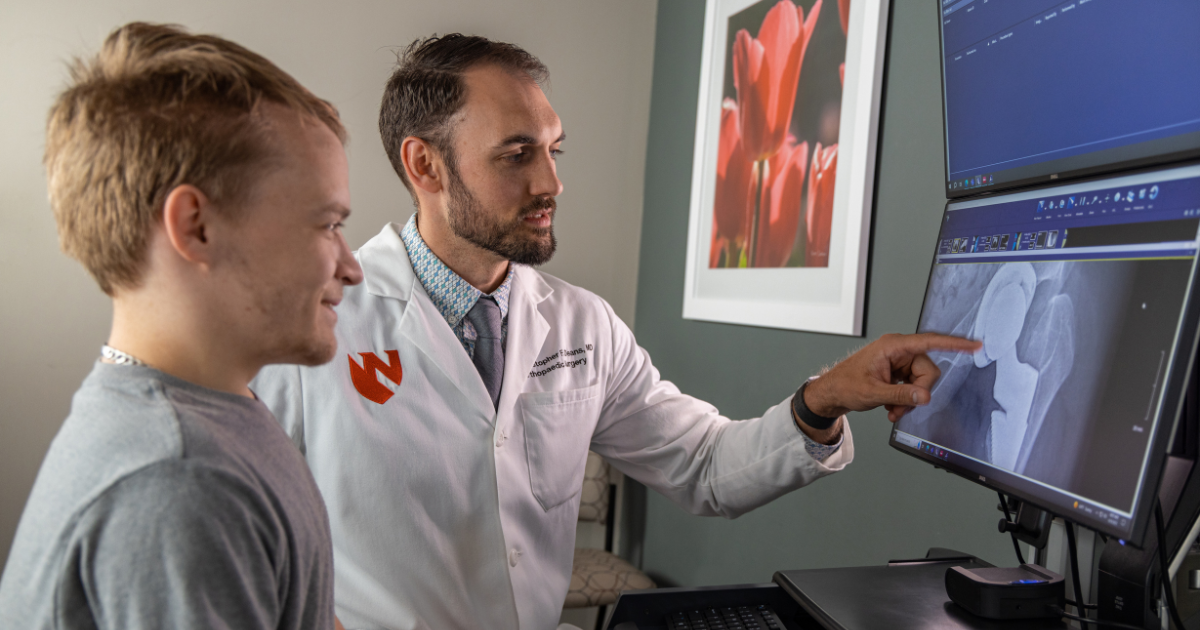Double hip replacement helps young patient pursue his dreams

Meet Donminick Murray. Like many 19-year-olds, he’s enjoying the independence that comes with moving out of his parents’ house and living on his own.
What sets Murray apart is how hard he had to work to get here. By age 18, he was hobbled from the pain of two arthritic hip joints. He was having trouble walking, couldn’t put on his shoes, and his cashiering job was becoming difficult. He had dreams of working in construction. “I’ve always wanted to build things,” he says – but chronic pain left him tired and demoralized.
Murray has dwarfism, which commonly results in hip dysplasia and arthritis at a young age. He managed well through his high school years in North Carolina, where he was an avid skateboarder, but by the time he graduated and moved with his family and fiancée to Omaha in 2022, he could barely walk. The pain, fatigue and lack of independence wore on him.
“I lived with my parents and couldn’t be a full adult on my own,” he says. “I was so tired. My quality of life wasn’t great compared to now.”
The ‘now’ Murray refers to is life after double hip replacements, one in late 2022 and another three months later. Less than a month after his second surgery, Murray was back at work, carrying ladders and heavy tools while running wires through multistory buildings as an apprentice electrician. A few months later, in June, he and his fiancée moved into their first home together.

“I live on my own, I’m an electrician, and I’m having a lot of fun,” he says. “My life is good.”
Orthopaedic surgeon Christopher Deans, MD, performed both surgeries and says Murray’s resilience and determination set him apart.
“Some of my patients are like racehorses, and he just happens to be one of them, to the point that I had to say, ‘Hey, remember, we just got done with a big operation to replace your hip. You’ve got to take it easy for a while.’”
The Nebraska Medicine orthopaedic team commonly performs hip replacements, Murray’s was unique and difficult due to his size and anatomical differences.
“From a surgical standpoint, these are difficult procedures,” Dr. Deans says. “They require all kinds of professionals in addition to the orthopaedic team, like a skilled operating room staff, floor nursing staff, anesthesiologists, etc. So Nebraska Medicine was a good place for him to be.”
Murray agrees that he was in good hands during his procedures and recovery.
“It was amazing,” he says. “They were so professional and respected all my wishes. They checked in on me, brought me my medicines and kept me an extra day after the first surgery because my body needed an extra day of recovery.”
After the first surgery, Murray spent two nights in the hospital and after the second surgery, just one. He admits he didn’t rest as much as he should have after the first surgery. He learned a lesson and, after the second surgery, took it easy for a week before beginning a diligent routine of stretching and working out.
“Dr. Deans did such a great job with the surgery, but I also took getting back to health very seriously,” he says. “After the second surgery, I slept. I babied myself for a week, like you’re supposed to, and then grew up and did the adult thing.”
Murray’s healing was helped along by his fiancée and his parents. His mother could relate, having undergone bilateral hip replacement when she was in her 30s. By that point, she had broken one of her hips and was in tremendous pain as she worked as a teacher. She encouraged Murray to have his surgeries at a younger age to avoid a similar experience.
Dr. Deans says Murray’s family deserves a shoutout for being at his side throughout the entire process.
“I always tell patients when they’re in our clinics that about 50% of how well they do is what we do in the hospital, surgically and medically,” he says.
“The other 50% is motivation, and the support network around them, and Donminick’s family was astronomically good at supporting him.”
As for motivation, Murray says he was driven by the desire to take care of his fiancée and support a family one day – something that seemed out of reach when he was exhausted by pain.
“Before, I felt stuck,” he says. “I felt like I was moving in slow motion. And now I feel like I’m working toward something.”
Dr. Deans says Murray will likely have to have hip replacement surgeries in the future, but he hopes not for “many, many years.” But Murray isn’t letting worries about the future weigh him down as he builds his future.
“I just know that I am way happier, way healthier, and on the track to a successful career. Life is good.”
A full range of orthopaedic care is accessible from a wide variety of Nebraska Medicine orthopaedic providers at Lauritzen Outpatient Center, Bellevue Medical Center and Village Pointe Health Center.







